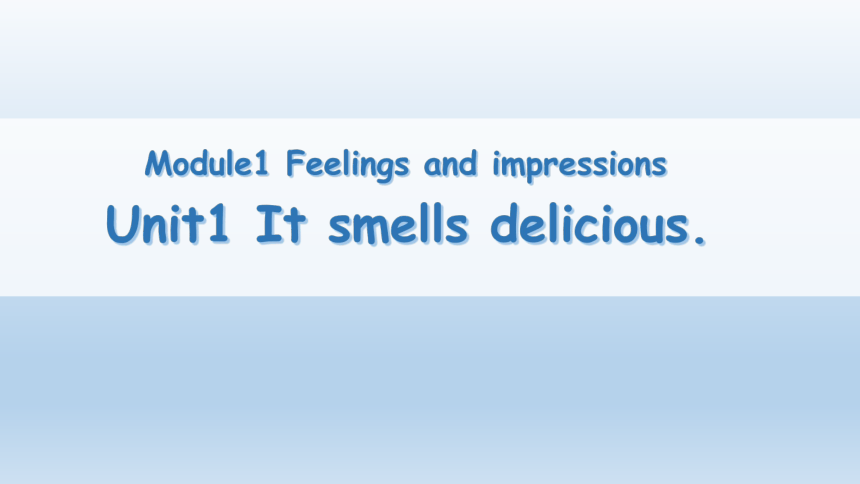(
课件网) Module1 Feelings and impressions Unit1 It smells delicious. New words and phrases 闻;闻出 v. 气味 n. 软的;柔软的 adj. 酸的;馊的 adj. 小甜饼;曲奇饼 n. 呣(表示食物味道好)int. 比萨饼 n. smell soft sour cookie mm pizza 令人愉快的;可爱的 adj. 做完的 adj. 尝试;努力 n. 尝一尝;试试看 馅饼;派 n. 听起来;令人觉得 v. lovely done try have a try pie sound 对甜食的爱好 盐;食盐 n. 果酱 n. 用于;(表示持续的时间) 达,计 prep. 最喜欢的人或事 n. 耳朵 n. sweet tooth salt jam for favourite ear Summary Tell your feelings, let people know you better. What food can you see How do they taste feel 摸起来 taste 尝起来 look 看起来 smell 闻起来 sound 听起来 beautiful strong delicious sour ··· “看闻摸听尝” 感官 感官动词 形容词 Eye look Nose smell Hand feel Ear sound Mouth taste smart, fresh, angry, worried delicious, fresh comfortable, soft, tight noisy, quiet delicious, fresh, salty, sour, strong, sweet Look and say It feels _____. feel 摸,摸起来给人以……感觉 How does the bear feel soft It smells _____. sour(酸的,馊的) strong (味道浓的) smell 闻,闻起来 How does the jam smell jam 果酱 How do the cookies taste taste 尝,尝起来 They taste _____. sweet I have a sweet tooth. 我爱好甜食。 cookie 小甜饼;曲奇饼 He looks _____. How does Xiao Wu look lovely(可爱的) look 看,看起来 I use ………. to look. I use ………. to listen. I use ………. to taste. I use ………. to smell. I use ………. to feel. What do you use (使用) to … 1.What a delicious smell! 多么香的气味啊! 感叹句:结构为: 1. “What + a/an+ 形容词+ 可数名词单数形式+主语+谓语!” What a useful book! 这本书真有用啊! What an old tree it is! 这棵树真古老啊! Language Points 3 3. I’m afraid I don’t like cheese. 恐怕我不喜欢奶酪。 be afraid 的用法 be afraid 后面接(that) 引导的宾语从句,意为“恐怕······” 表示遗憾、惋惜或表示因不愿意做某事儿有意让口气显得缓和,其否定形式为I’m afraid not ··· I’m afraid (that) some of you will fail the exam. 我恐怕你们中的一些人会考试不及格 1) be afraid to do sth. 害怕做某事 I’m afraid to swim in the river.我害怕下河游泳。 2) be afraid of sth. 害怕··· They are afraid of him. 他们怕他。 2.What +形容词+可数名词复数+主语+谓语! What good children they are!他们真是好孩子! What beautiful flowers they are!花儿真美! 3.What +形容词+不可数名词+主语+谓语! What delicious food it is!食物真美味! What heavy snow it is!雪真大! 4.感叹句也常用how 引导。其结构为: How + 形容词或副词+主语+谓语(系动词)! How lovely the baby is!这个小孩子真可爱! How fast he is running!他跑的真快! Grammar 感官系动词:英语动词中,有的后面要接名词或代词等作宾语,有的单独作谓语,而有的后面要接形容词或名词等做主语的补充成分。我们把后面接主语补充成分的动词称为系动词。最常用的系动词是be,另外还有很多感官动词,如:look, taste, feel, smell, sound等。例如: 感官动词的用法 2.感官动词为半系动词:在结构上处在系动词的位置,但在变为否定句或疑问句时须借助于助动词。 e.g. Does he look happy He doesn’t look happy. 1.结构: 主语+感 ... ...

